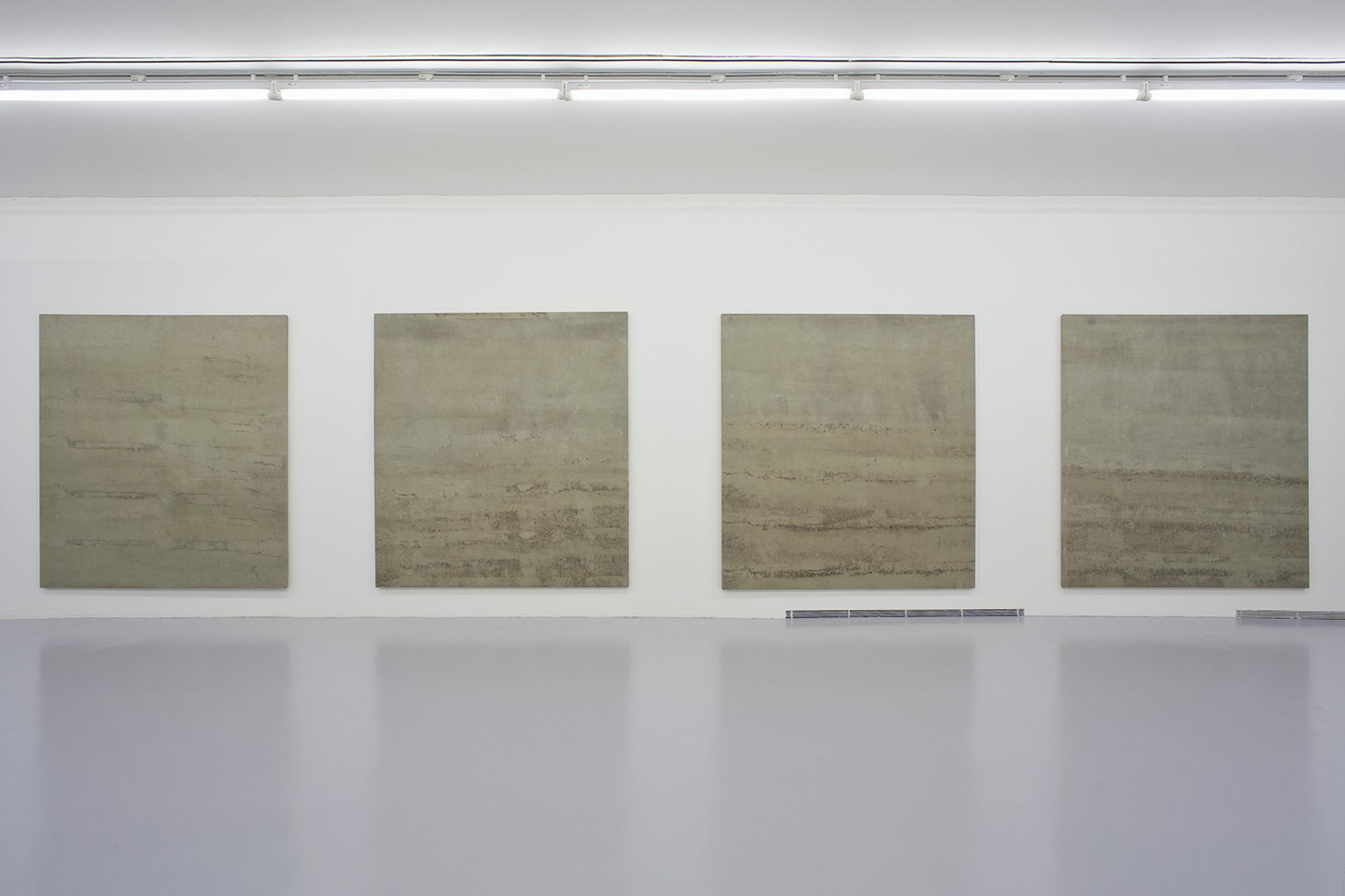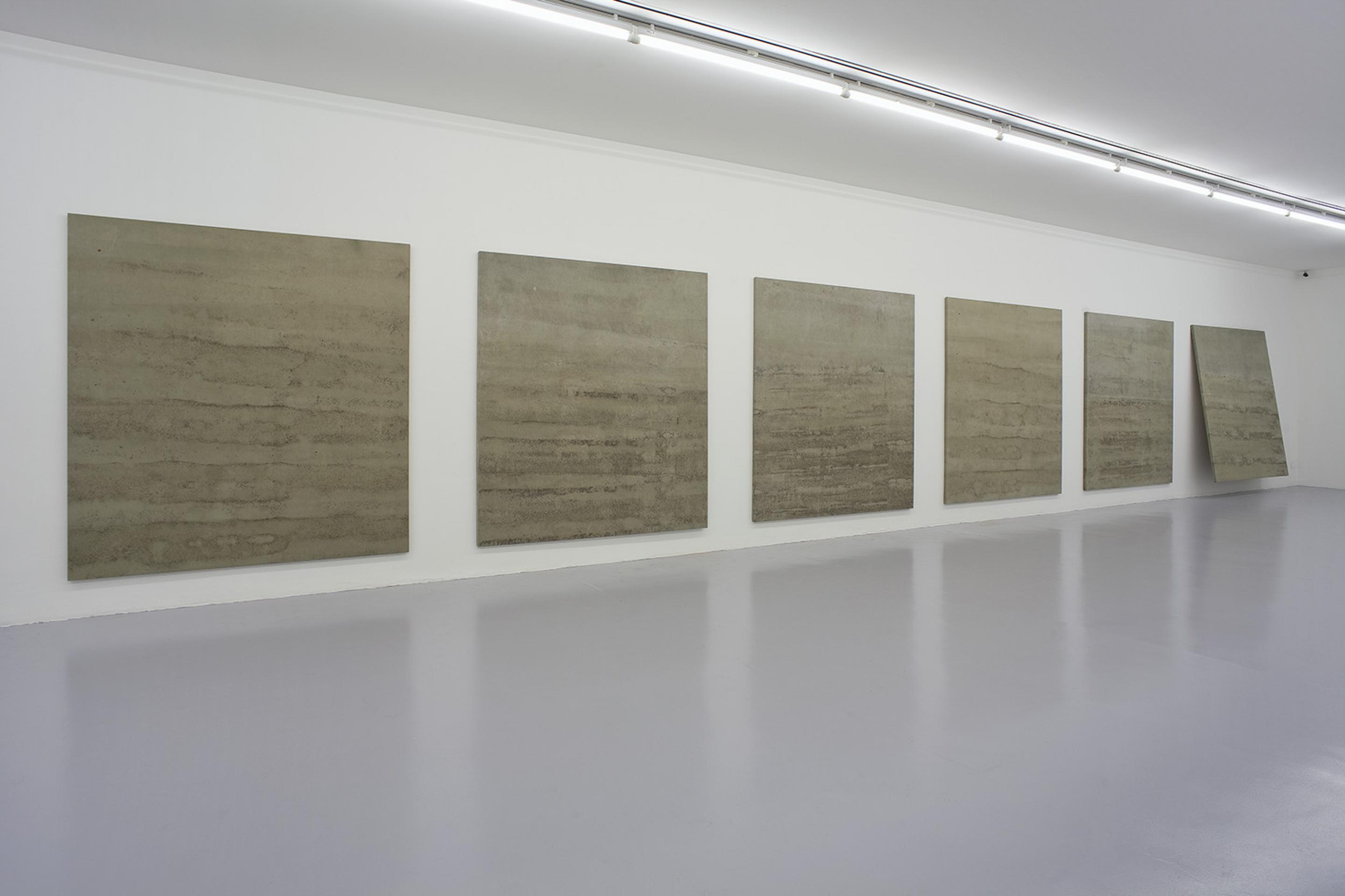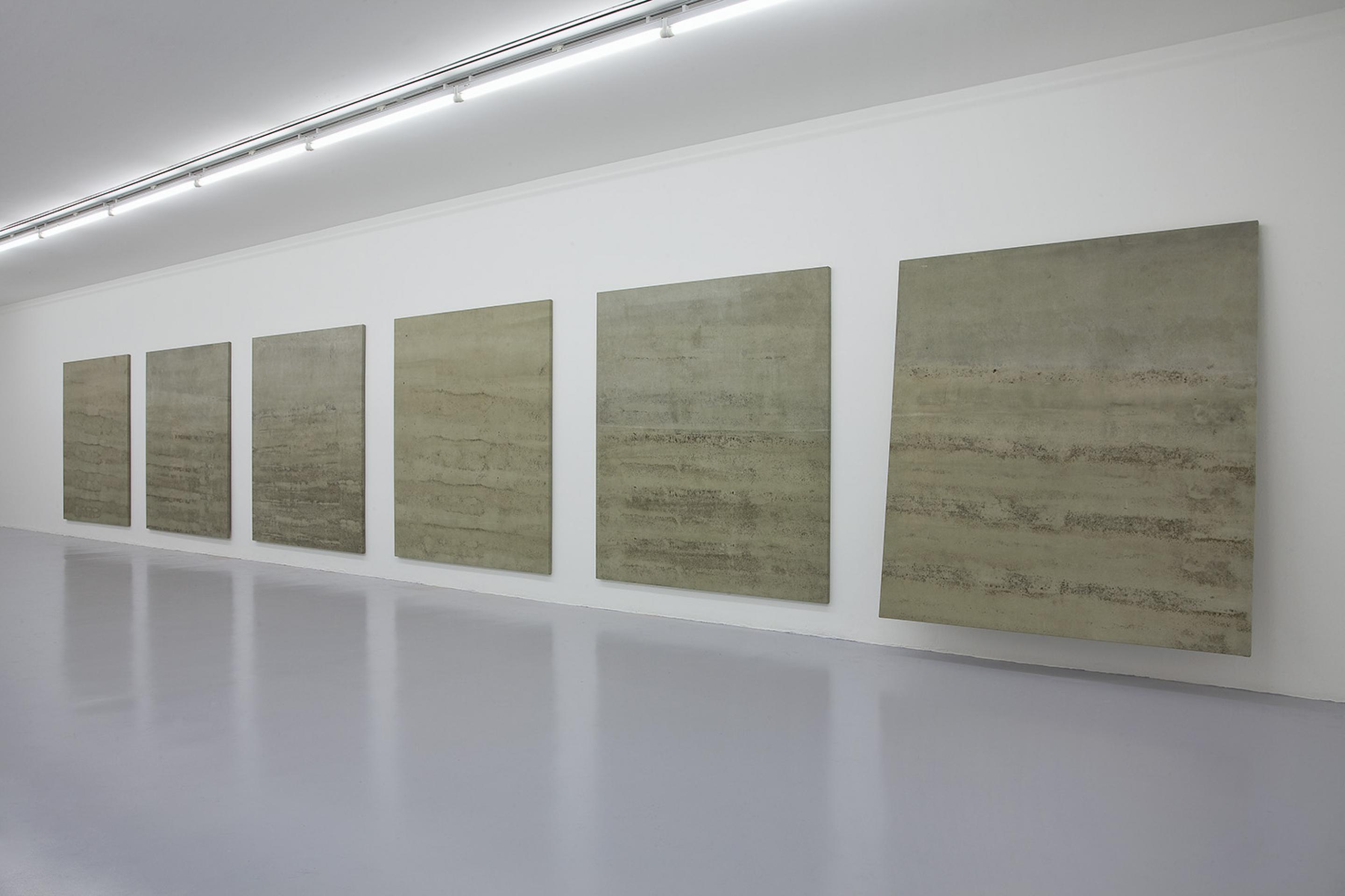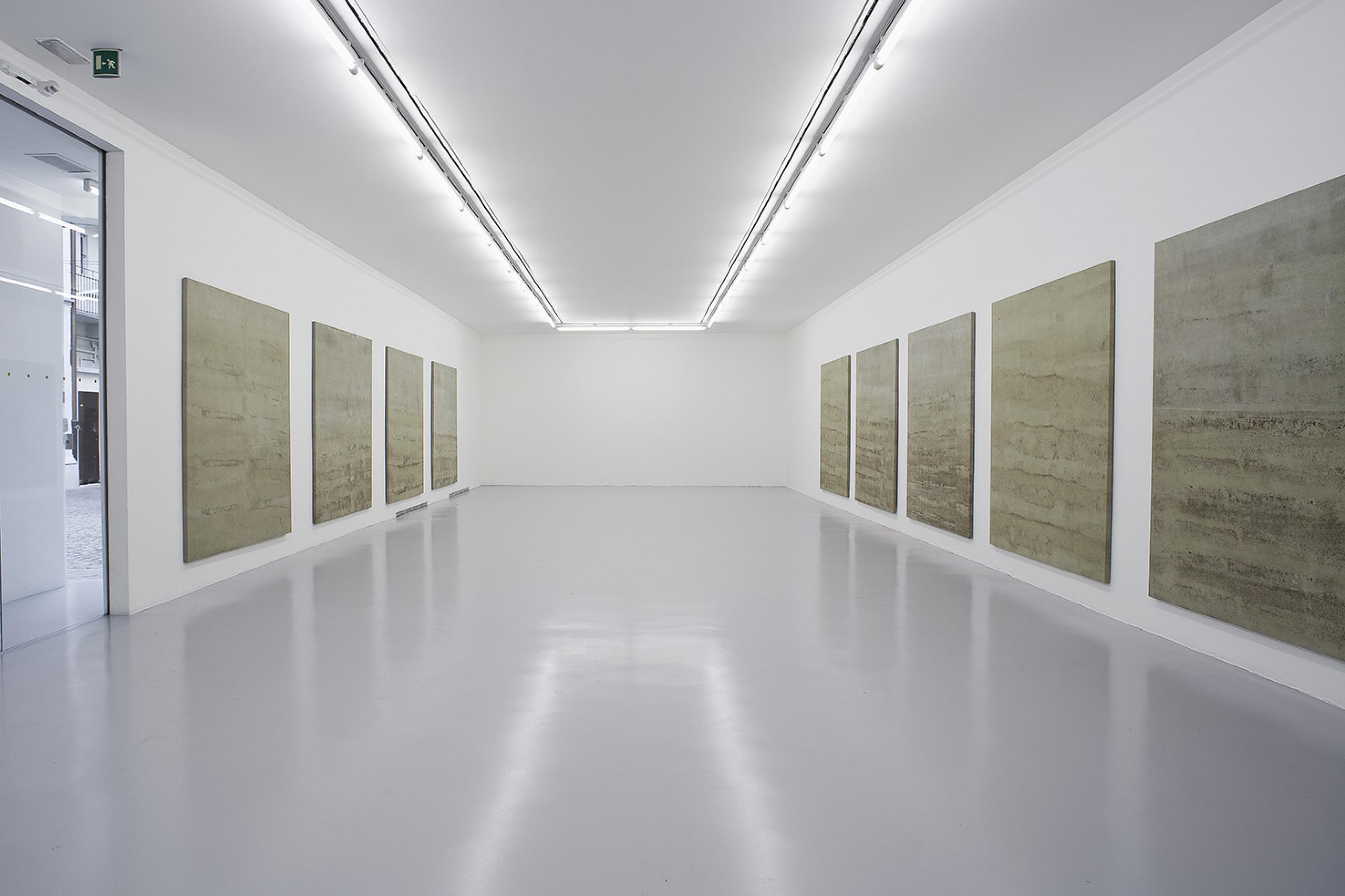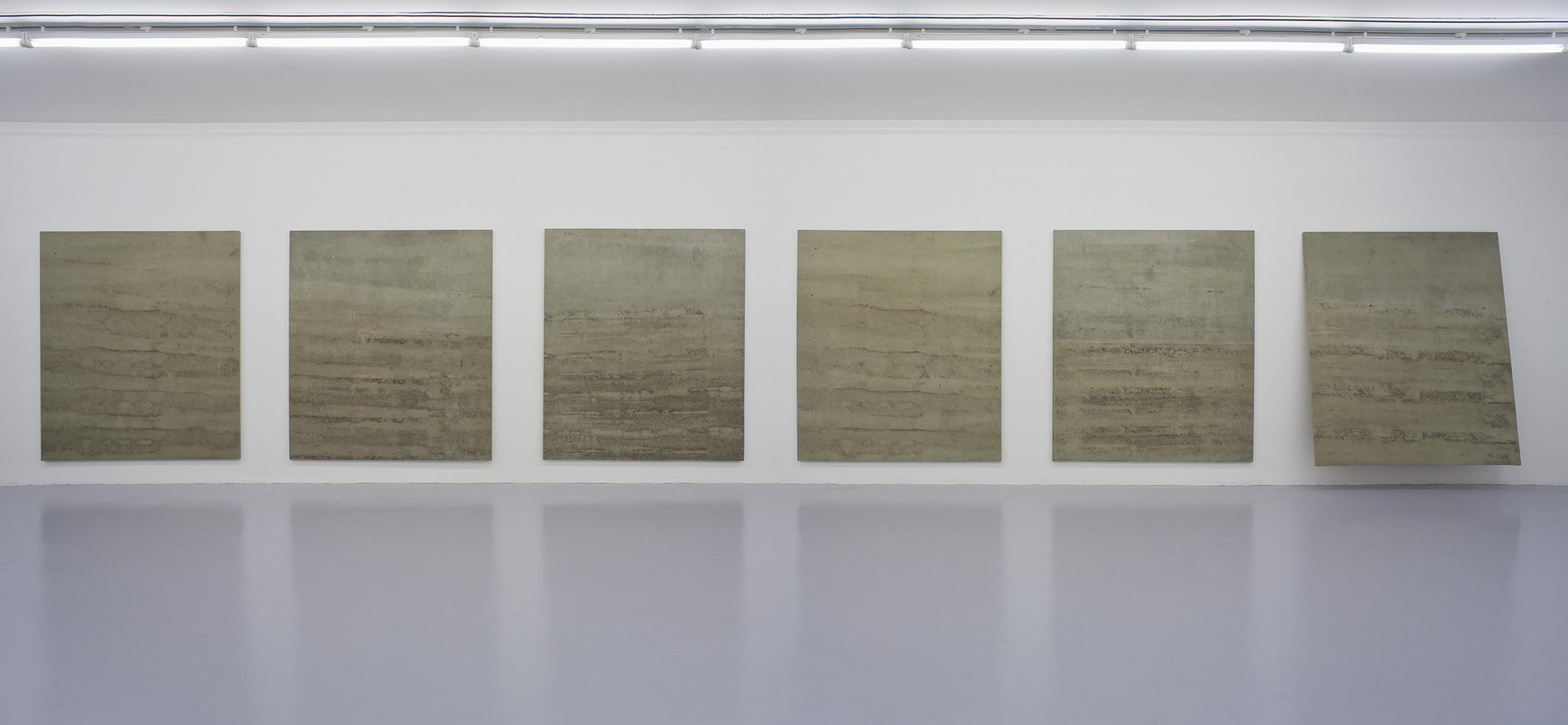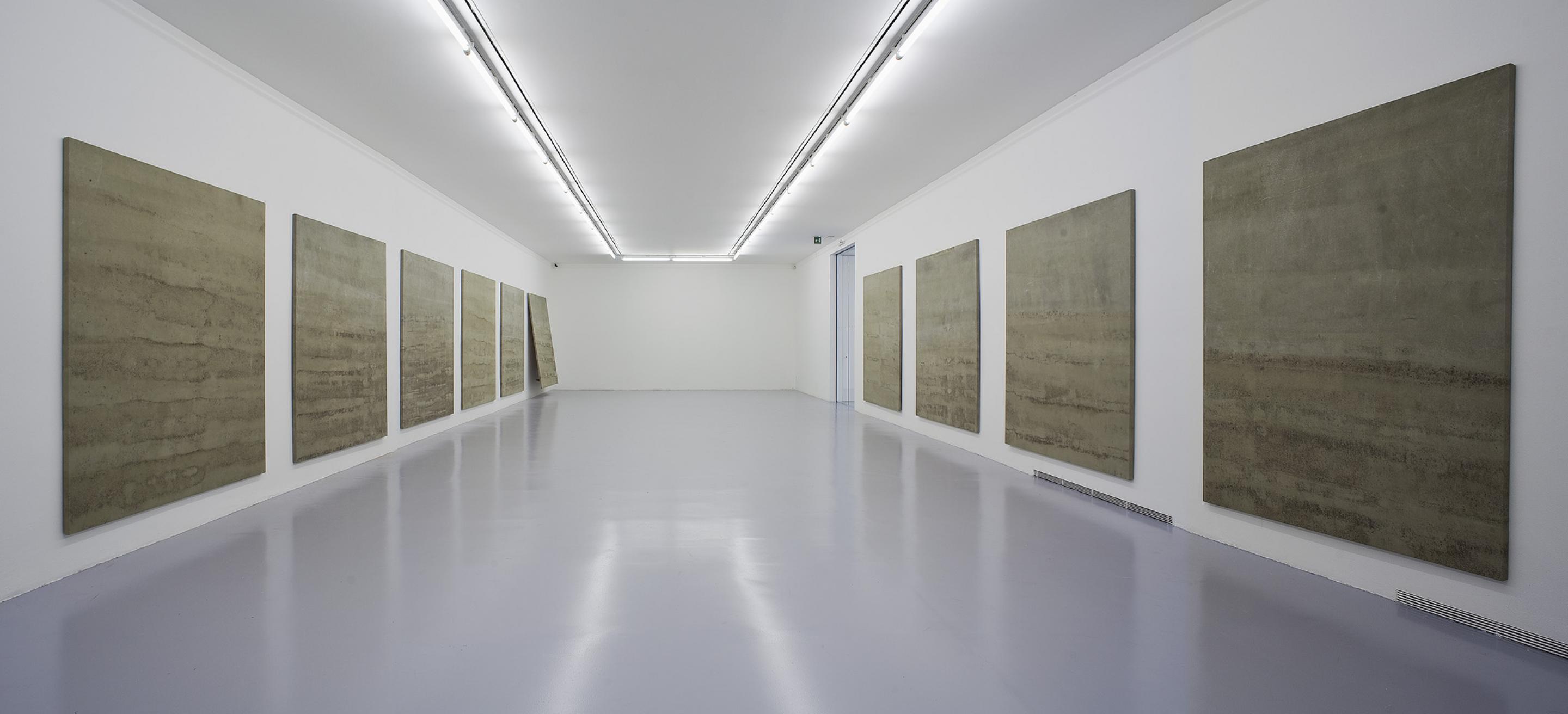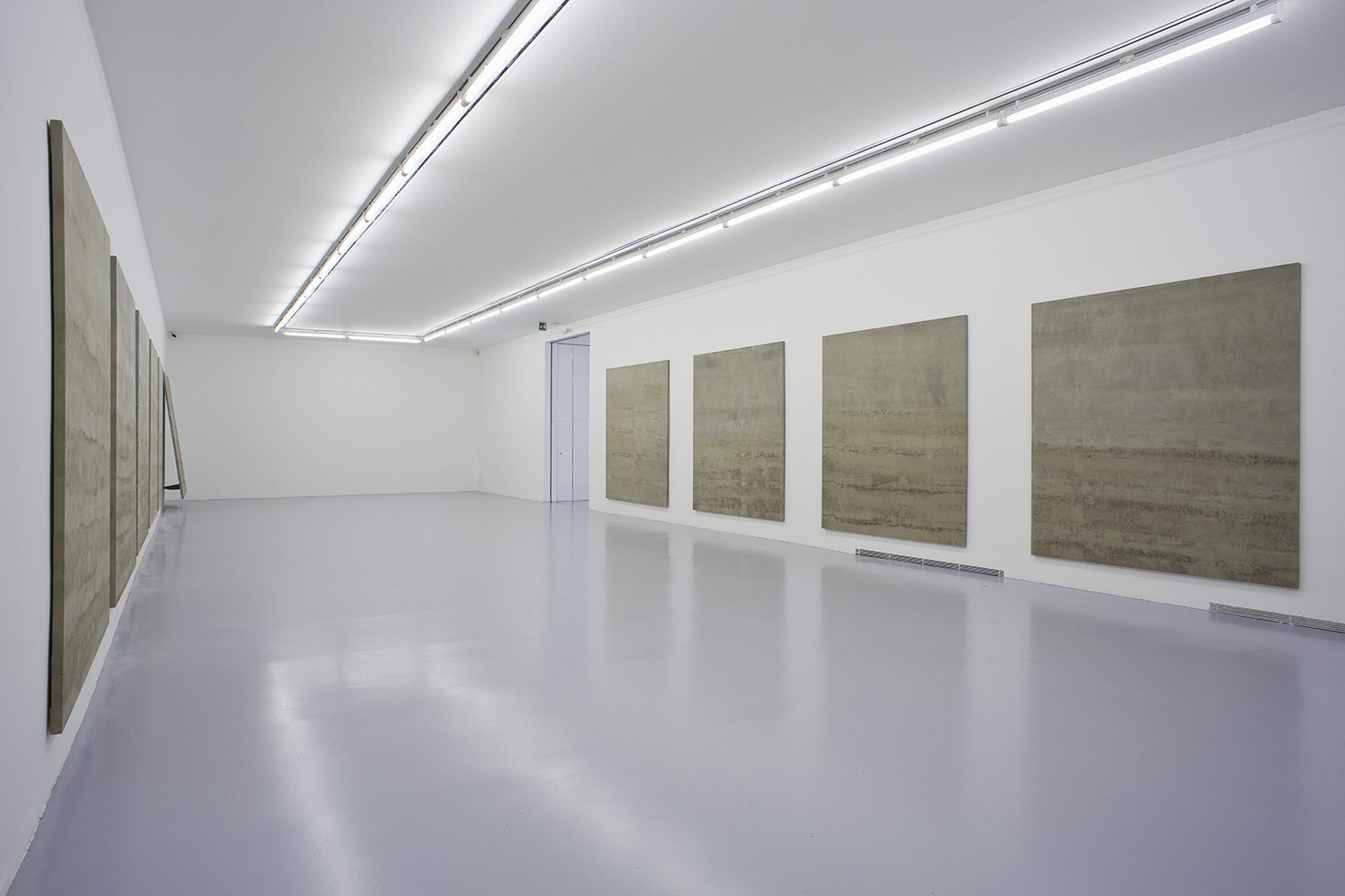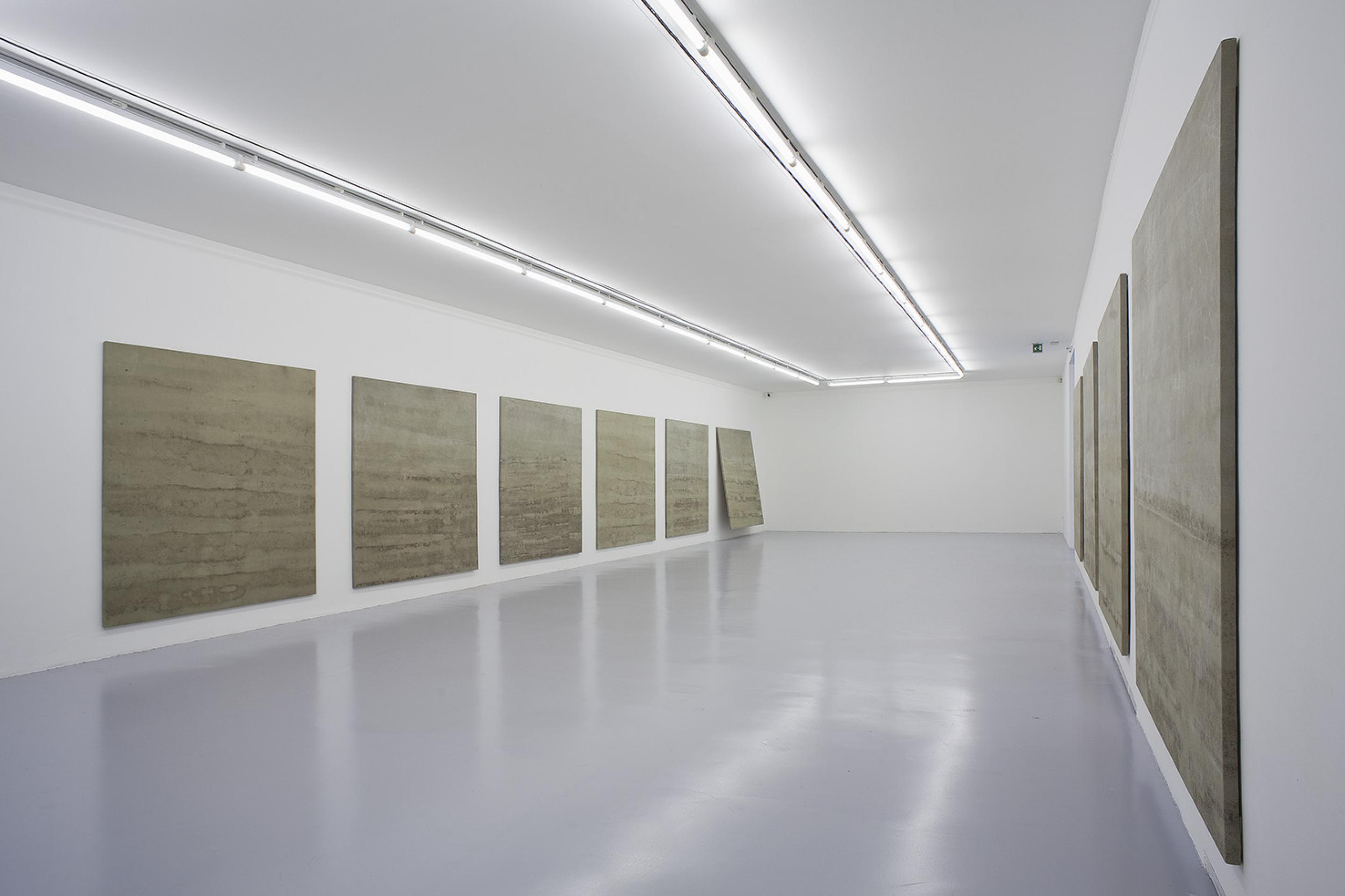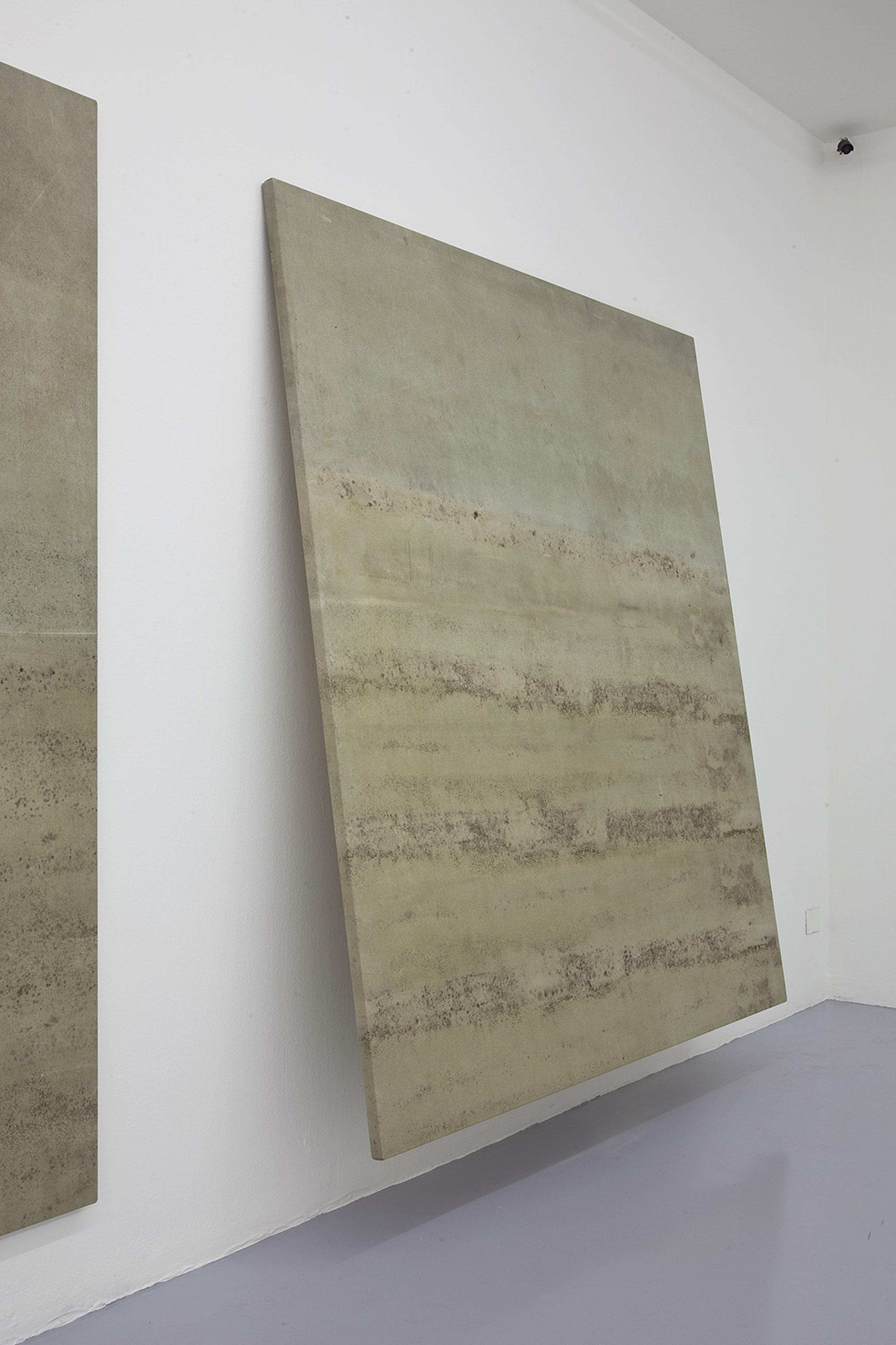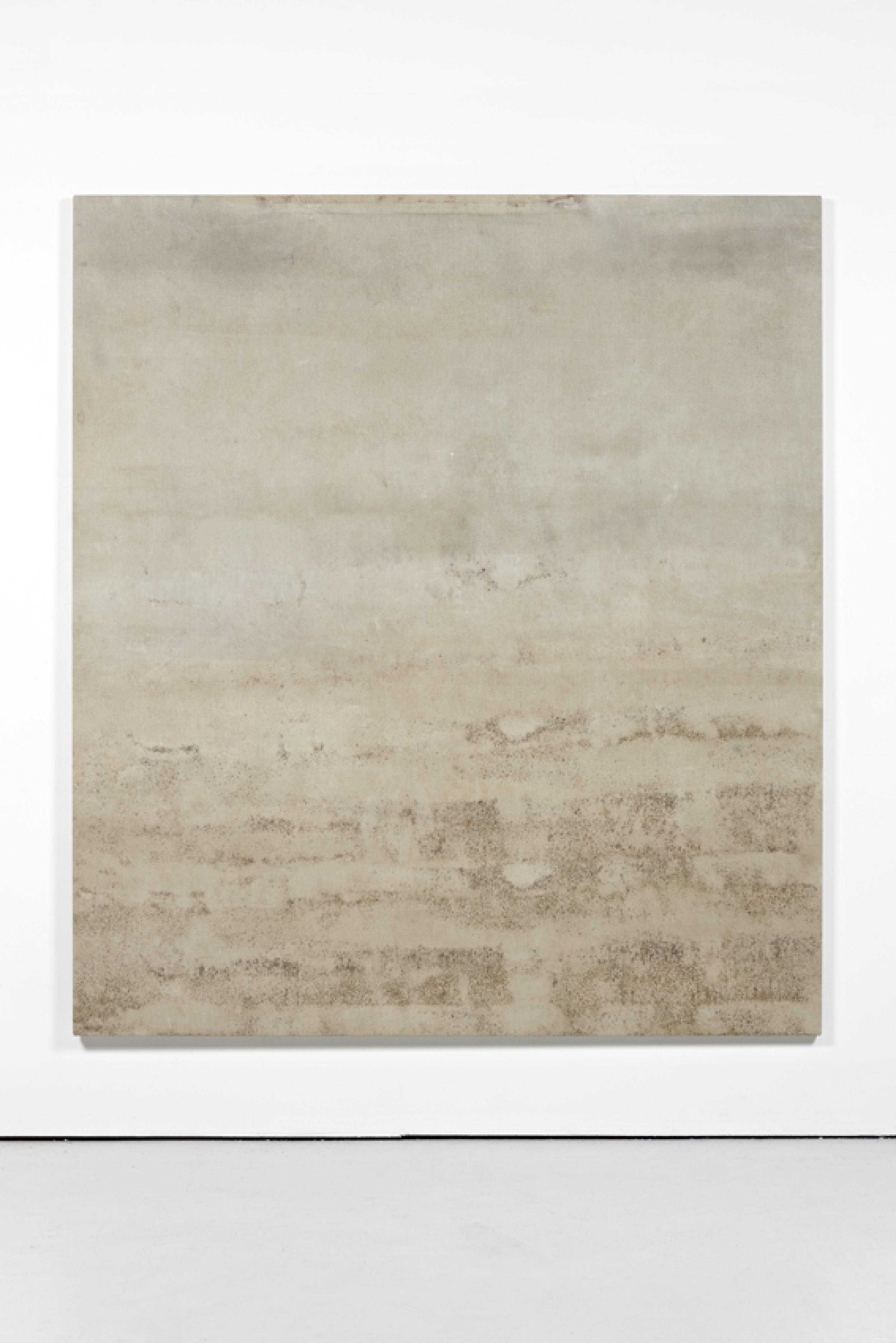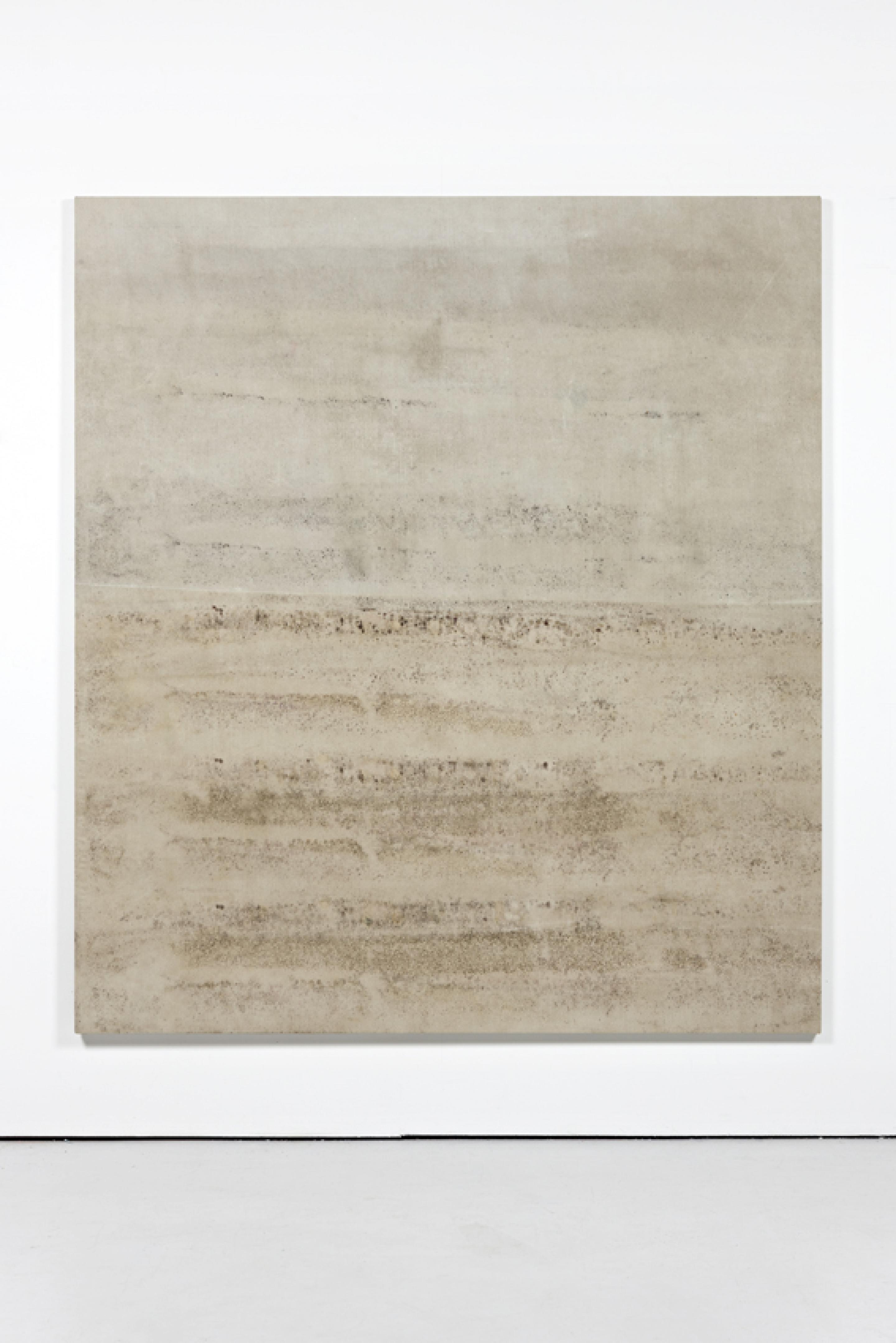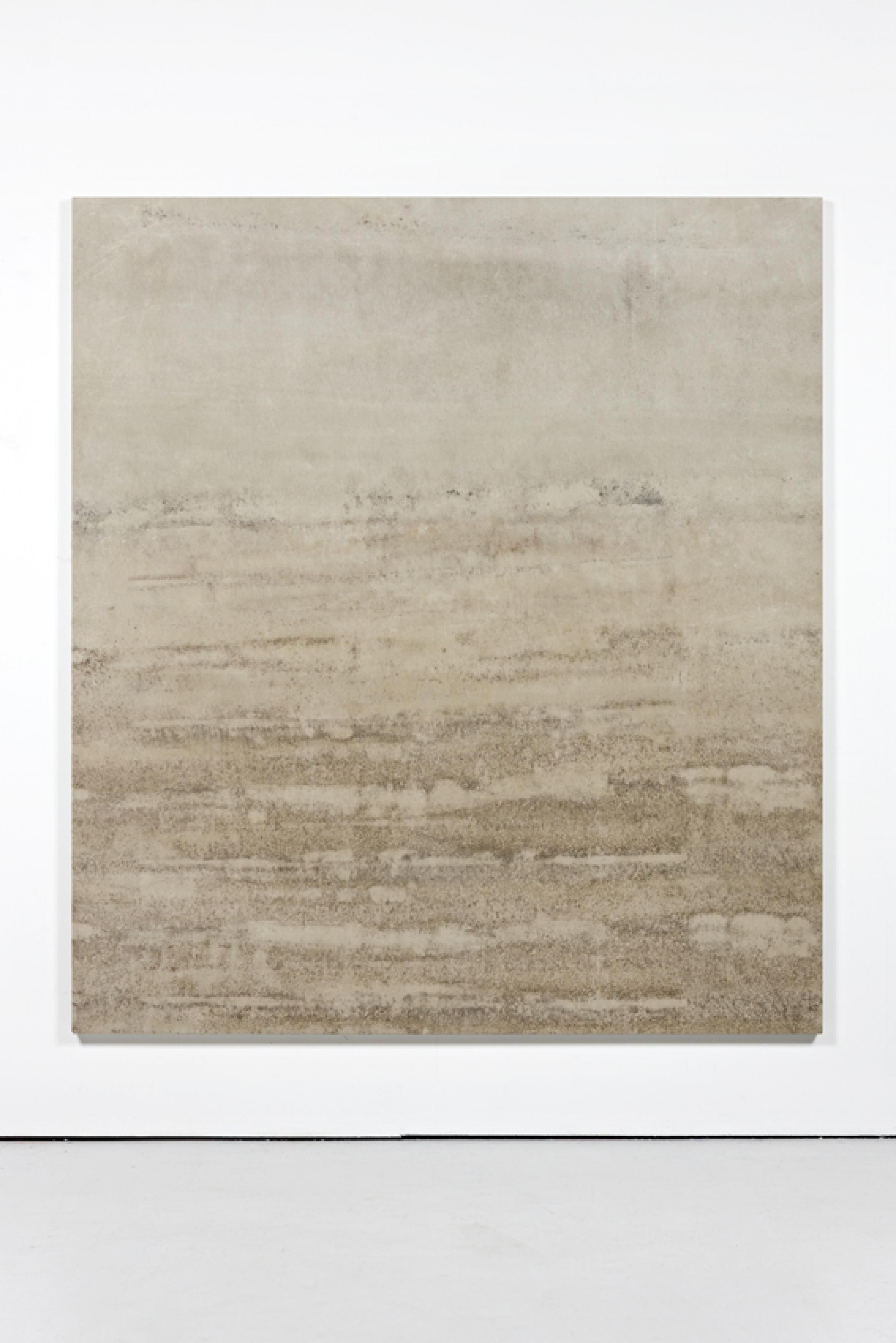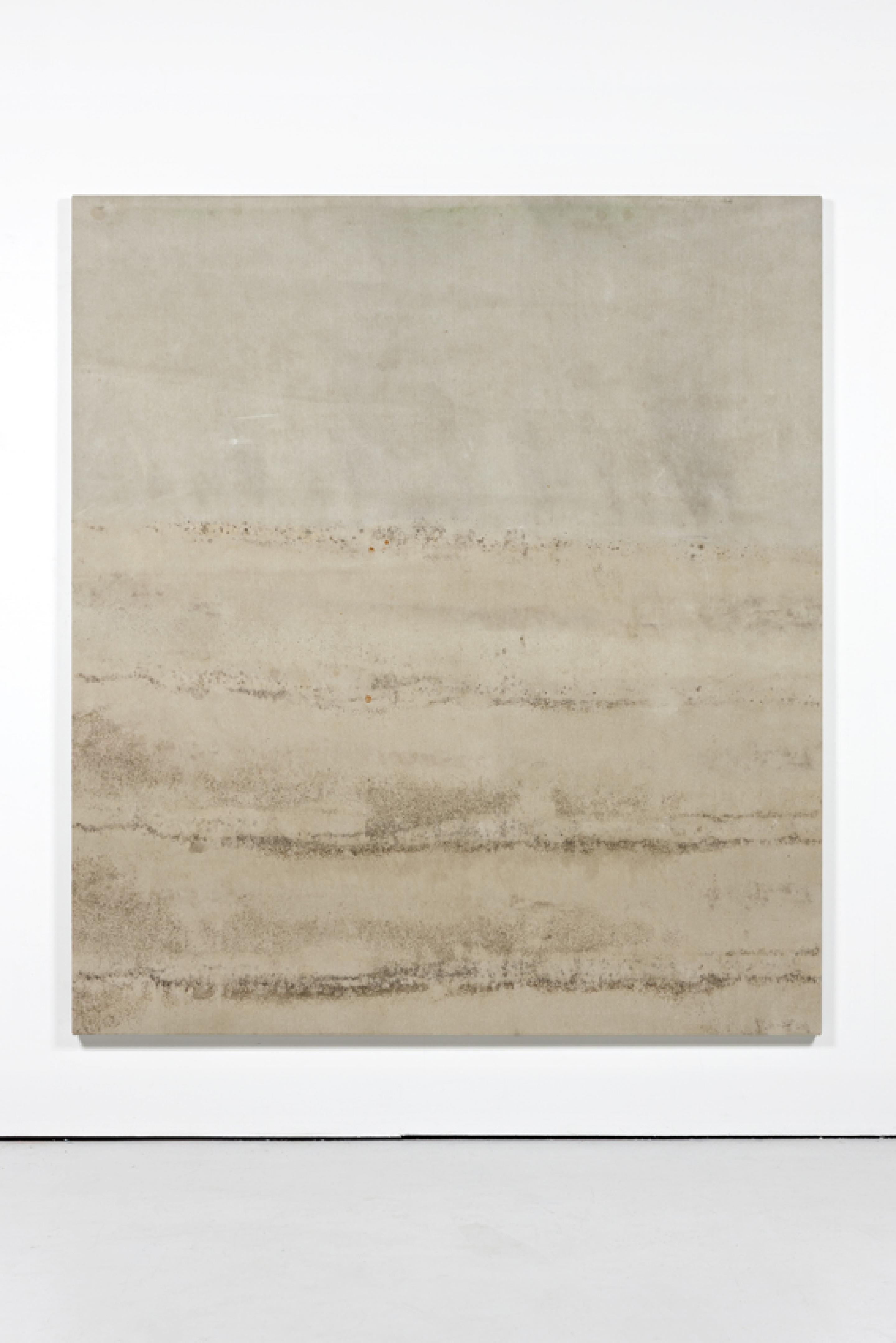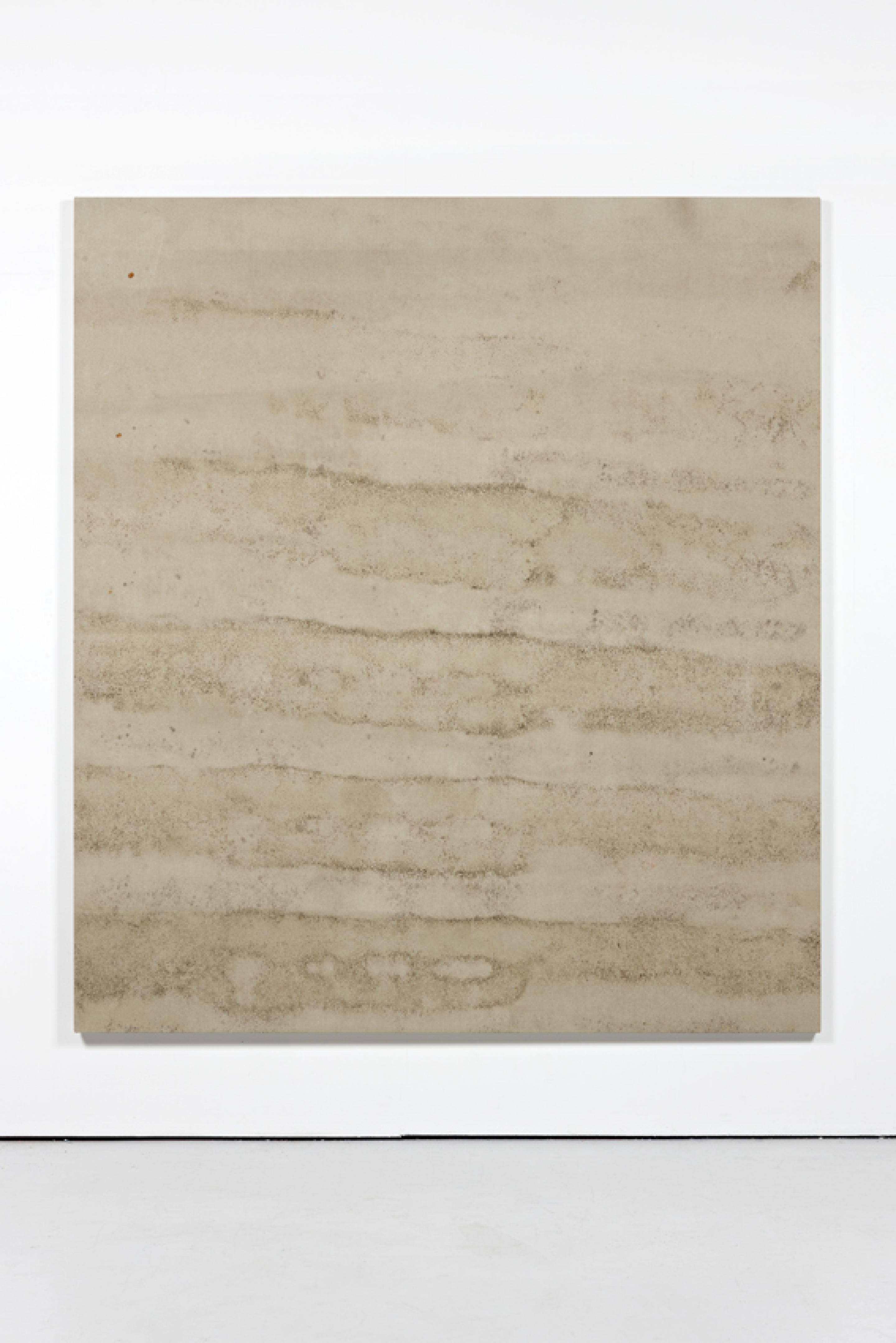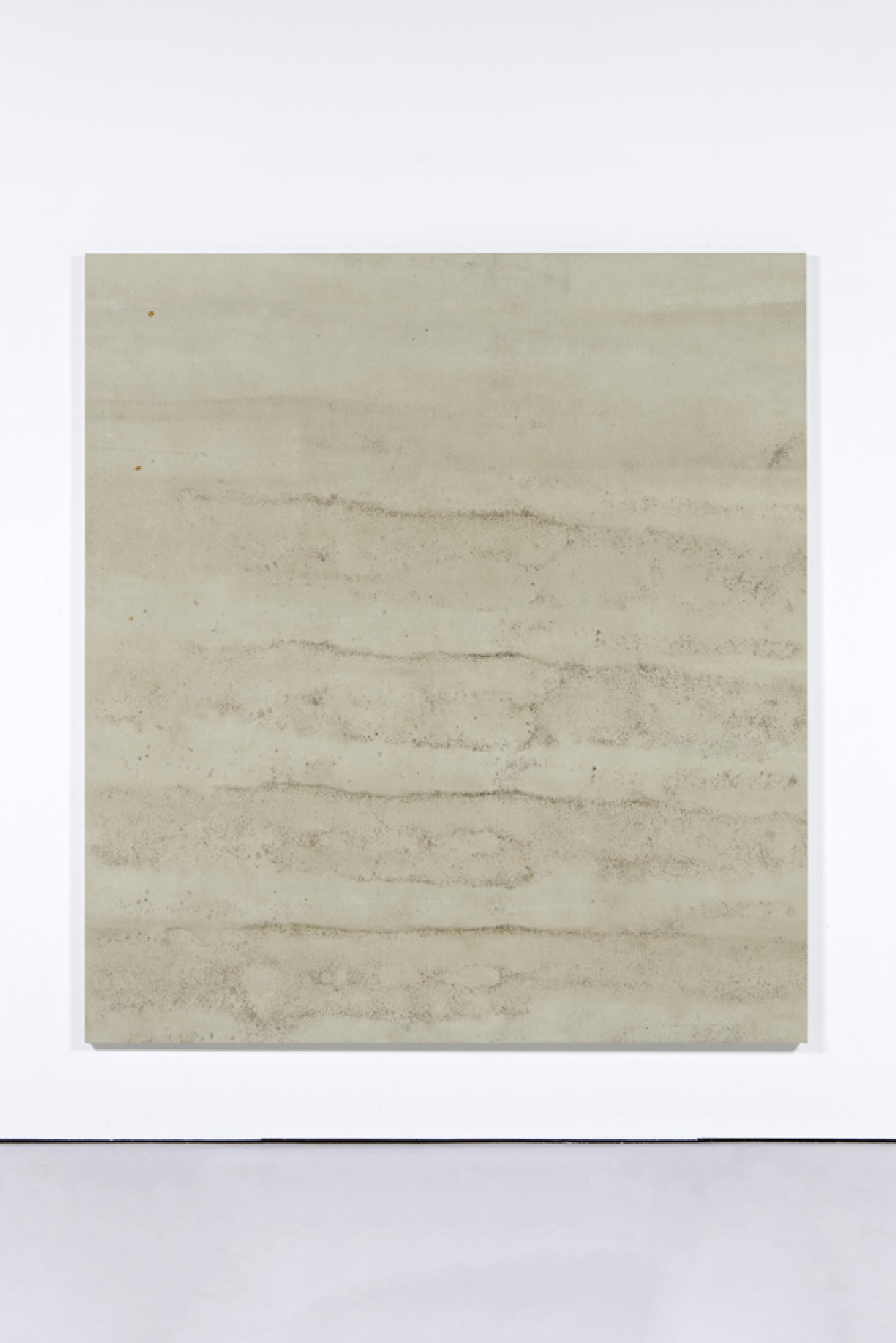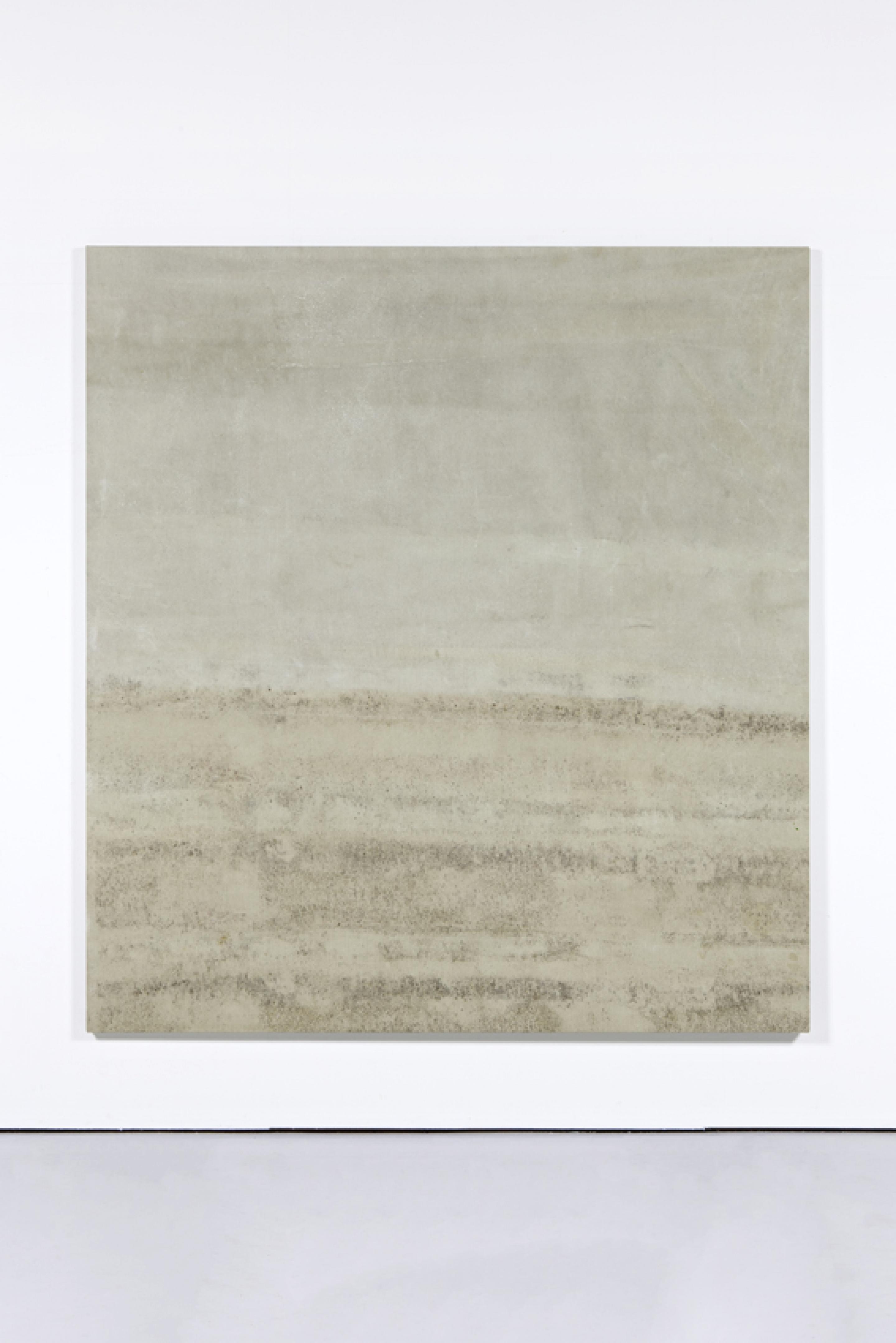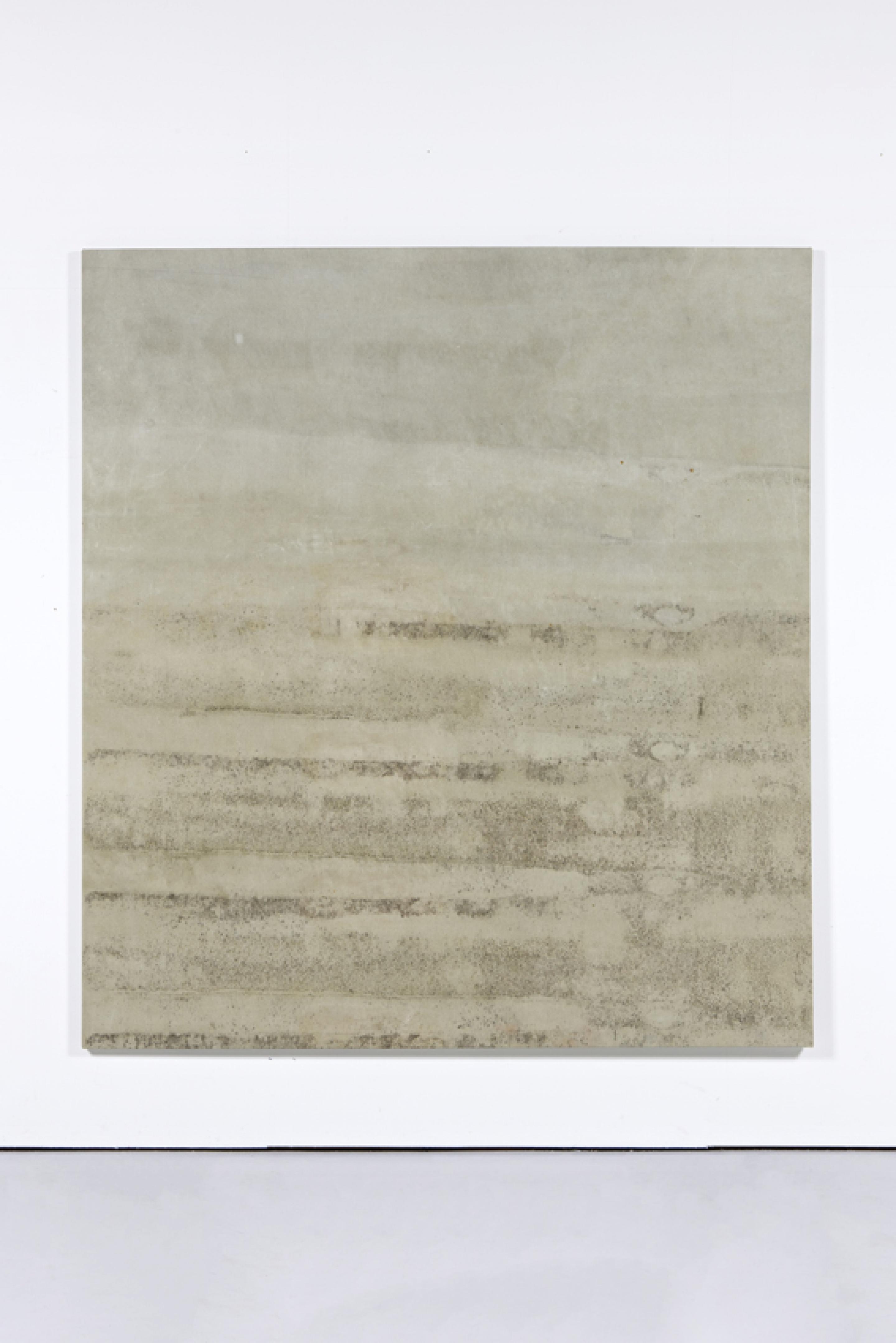FredrikVÆRSLEV
Choppy Times
Gió Marconi, Milan
26.09.–09.11.2013
Choppy Times
Gió Marconi, Milan
26.09.–09.11.2013
FredrikVÆRSLEV
IT
Fredrik Værslev
Choppy Times
Inaugurazione: giovedì, 26 settembre, dalle 19 alle 21
27 settembre - 9 novembre, 2013
martedì - sabato, 10-19
Giò Marconi ha il piacere di presentare in parallelo due mostre personali di Lucie Stahl e Fredrik Værslev.
Una delle caratteristiche che attestano di più il “non-progetto” pittorico di Fredrik Værslev è un'implacabile, ma tuttavia palpabile e rigorosamente tranquilla, destabilizzazione dell'apposizione dei segni distintivi, "segni del mondo", e vettori e variazioni diversi di pura contingenza. Sembra come se il mondo visivo e tattile che viene preso in giro in primo piano nel suo lavoro sia sempre sul punto di crollare sotto il peso della propria presupposta inesistenza.
In inglese la parola muffa, mildew, ha in sé quasi come un delicato senso di bellezza, in effetti deriva dall’inglese antico mildÄ“aw, “melata”, e la prima parte del vocabolo contiene il termine latino e greco usato per miele, - mel e meli. Abbastanza strano, dato che la parola descrive tutto tranne che la dolcezza del miele; ma al contrario la decomposizione, la putrefazione e le ife fungine su materiale organico. Se si considera il sostantivo norvegese che si usa per muffa ci si scontra subito con un netto contrasto perché “jordslag” significa letteralmente pennellata di terra/sporco. Questa effettiva contraddizione che emerge nella traduzione tra l’inglese e il norvegese in qualche modo, pure se accidentalmente, si rileva anche nell’ambiguità che si vede e si percepisce nell’ultima serie di dipinti di Værslev. In queste opere più recenti il fenomeno e il noumeno processuale della muffa costituiscono l’elemento gestuale principale.
Tele grezze preparate con dell’imprimitura mescolata a pigmenti, vengono lasciate fuori dallo studio dell’artista ad asciugare, successivamente vengono arrotolate saldamente attorno a tubi di plastica per poi essere lasciate all’aperto per circa dodici mesi. Dopo un anno di usura e di segni provocati da tutte le quattro stagioni del mutevole clima norvegese, le tele vengono srotolate e sulla parte superiore di queste si trovano attacchi delle muffe più o meno evidenti. Grazie alla tecnica di piegatura diventano visibili composizioni ripetitive - ma uniche allo stesso tempo - di muffe e imprimitura/pigmento. Le tele sono poi sottoposte ad un lavaggio rigoroso con funghicidi e infine lasciate ad asciugare sia all’interno che all’esterno durante l’inverno. Oltre alle associazioni potenzialmente negative dovute alla sgradevole decomposizione della muffa, il fatto che le tele vengano trattate con un sistema meticoloso ricorda un po’ il modo con cui si preparano sia la carne che il pesce (vengono in mente piatti tipici norvegesi come il gravlax e il rakfish ‘pesce fermentato’), i dipinti con la muffa esposti nella mostra Choppy Times portano con loro un senso di materia, di decomposizione, di sporco e perfino di morte. Forse ancor più che nelle serie precedenti di Værslev, come ad esempio nei dipinti che rievocano il (ormai obsoleto e di "buon gusto") terrazzo alla veneziana, i canopy o i garden paintings. Questi ultimi sarebbero forse i più simili ai più recenti aggiunti alla famiglia. Detto questo, le nuove opere in mostra rappresentano anche una continuazione approfondita dei "canopies" monocromi degli ultimi anni. Anche se mirano a togliere la funzionalità e la socialità architettonica della tela.
Questi dipinti, permeati di muffa, aggiungono così una cupa nota di gravità, di morte e del lasciarsi morire al lavoro in continua evoluzione di Værslev. E, soprattutto, queste opere portano avanti la paziente e rigorosa esplorazione dell'artista nei confronti del segno e della ripetizione. Se, per così dire, i canopies hanno aggiunto segni anonimi e senza volto di sobborghi architettonicamente e socialmente insignificanti, e allo stesso modo i garden paintings eco-ontologicamente hanno aggiunto segni del "mondo", l'ultima serie aggiunge un elemento di temporalità che si potrebbe chiamare "segno temporale" come i motivi iterativi causati sia dalla piegatura intorno ai tubi di plastica, dalla muffa e dalle condizioni del tempo - e la possibilità della ripetizione è infatti il fondamento di qualsiasi segno; marcano il passaggio ciclico di un anno con la ripetizione e con l'assoluta, singolare contingenza. In questo senso, queste opere intensificano anche la problematica della serialità che è sempre presente nel lavoro di Værslev. Queste opere sono, in modo molto lontano, legate ai dipinti-data di On Kawara, ma evocano una temporalità e spazi aperti, senza e al di fuori dell'interazione umana, dei percorsi e degli schemi. Un'epistemologia non umana ed enfaticamente increspata di pittura e segni. Ma solo in apparenza.
Peter J. Amdam
Fredrik Værslev è nato nel 1979 a Moss, in Norvegia. Ha studiato alla Staatliche Hochschule fur Bildende Künste, Städelschule, a Francoforte e presso la Malmö Art Academy, in Svezia. Attualmente vive e lavora a Drøbak e a Vestfossen. E’ direttore e fondatore del Landings Project Space a Vestfossen in Norvegia. Tra le sue ultime e prossime personali: Andrew Kreps Gallery, New York; Luminar Cité, Lisbona; Power Station, Dallas; The World is Your Oyster, Circus, Berlino; Rubbish, con Ståle Vold, Johan Berggren Gallery, Malmö; Lanterne Rouge, STANDARD, Oslo; Sunny Side Up, Indipendenza Studio, Roma e That came out a Little Country, Front Desk Apparatus, New York.Tra le recenti e prossime mostre collettive: Modern Institiute, Glasgow; Flex-Sil Reloaded, Kunsthalle St. Gallen, St. Gallen; Lunds Konsthall, Lund; Awaiting Immenence, Isbrytaren, Stoccolma; Lies about Painting, Moderna Museet, Malmö; A Human Interval, Circus, Berlino; Fruits de la Passion, Centre Georges Pompidou, Parigi; Collaborations & Interventions, Kunsthalle Andratx, Maiorca; Priority moments, Herald St, Londra; Le Printemps de Septembre, The Museum les Abbatoirs & Croix Baragnon, Tolosa.
Choppy Times
Inaugurazione: giovedì, 26 settembre, dalle 19 alle 21
27 settembre - 9 novembre, 2013
martedì - sabato, 10-19
Giò Marconi ha il piacere di presentare in parallelo due mostre personali di Lucie Stahl e Fredrik Værslev.
Una delle caratteristiche che attestano di più il “non-progetto” pittorico di Fredrik Værslev è un'implacabile, ma tuttavia palpabile e rigorosamente tranquilla, destabilizzazione dell'apposizione dei segni distintivi, "segni del mondo", e vettori e variazioni diversi di pura contingenza. Sembra come se il mondo visivo e tattile che viene preso in giro in primo piano nel suo lavoro sia sempre sul punto di crollare sotto il peso della propria presupposta inesistenza.
In inglese la parola muffa, mildew, ha in sé quasi come un delicato senso di bellezza, in effetti deriva dall’inglese antico mildÄ“aw, “melata”, e la prima parte del vocabolo contiene il termine latino e greco usato per miele, - mel e meli. Abbastanza strano, dato che la parola descrive tutto tranne che la dolcezza del miele; ma al contrario la decomposizione, la putrefazione e le ife fungine su materiale organico. Se si considera il sostantivo norvegese che si usa per muffa ci si scontra subito con un netto contrasto perché “jordslag” significa letteralmente pennellata di terra/sporco. Questa effettiva contraddizione che emerge nella traduzione tra l’inglese e il norvegese in qualche modo, pure se accidentalmente, si rileva anche nell’ambiguità che si vede e si percepisce nell’ultima serie di dipinti di Værslev. In queste opere più recenti il fenomeno e il noumeno processuale della muffa costituiscono l’elemento gestuale principale.
Tele grezze preparate con dell’imprimitura mescolata a pigmenti, vengono lasciate fuori dallo studio dell’artista ad asciugare, successivamente vengono arrotolate saldamente attorno a tubi di plastica per poi essere lasciate all’aperto per circa dodici mesi. Dopo un anno di usura e di segni provocati da tutte le quattro stagioni del mutevole clima norvegese, le tele vengono srotolate e sulla parte superiore di queste si trovano attacchi delle muffe più o meno evidenti. Grazie alla tecnica di piegatura diventano visibili composizioni ripetitive - ma uniche allo stesso tempo - di muffe e imprimitura/pigmento. Le tele sono poi sottoposte ad un lavaggio rigoroso con funghicidi e infine lasciate ad asciugare sia all’interno che all’esterno durante l’inverno. Oltre alle associazioni potenzialmente negative dovute alla sgradevole decomposizione della muffa, il fatto che le tele vengano trattate con un sistema meticoloso ricorda un po’ il modo con cui si preparano sia la carne che il pesce (vengono in mente piatti tipici norvegesi come il gravlax e il rakfish ‘pesce fermentato’), i dipinti con la muffa esposti nella mostra Choppy Times portano con loro un senso di materia, di decomposizione, di sporco e perfino di morte. Forse ancor più che nelle serie precedenti di Værslev, come ad esempio nei dipinti che rievocano il (ormai obsoleto e di "buon gusto") terrazzo alla veneziana, i canopy o i garden paintings. Questi ultimi sarebbero forse i più simili ai più recenti aggiunti alla famiglia. Detto questo, le nuove opere in mostra rappresentano anche una continuazione approfondita dei "canopies" monocromi degli ultimi anni. Anche se mirano a togliere la funzionalità e la socialità architettonica della tela.
Questi dipinti, permeati di muffa, aggiungono così una cupa nota di gravità, di morte e del lasciarsi morire al lavoro in continua evoluzione di Værslev. E, soprattutto, queste opere portano avanti la paziente e rigorosa esplorazione dell'artista nei confronti del segno e della ripetizione. Se, per così dire, i canopies hanno aggiunto segni anonimi e senza volto di sobborghi architettonicamente e socialmente insignificanti, e allo stesso modo i garden paintings eco-ontologicamente hanno aggiunto segni del "mondo", l'ultima serie aggiunge un elemento di temporalità che si potrebbe chiamare "segno temporale" come i motivi iterativi causati sia dalla piegatura intorno ai tubi di plastica, dalla muffa e dalle condizioni del tempo - e la possibilità della ripetizione è infatti il fondamento di qualsiasi segno; marcano il passaggio ciclico di un anno con la ripetizione e con l'assoluta, singolare contingenza. In questo senso, queste opere intensificano anche la problematica della serialità che è sempre presente nel lavoro di Værslev. Queste opere sono, in modo molto lontano, legate ai dipinti-data di On Kawara, ma evocano una temporalità e spazi aperti, senza e al di fuori dell'interazione umana, dei percorsi e degli schemi. Un'epistemologia non umana ed enfaticamente increspata di pittura e segni. Ma solo in apparenza.
Peter J. Amdam
Fredrik Værslev è nato nel 1979 a Moss, in Norvegia. Ha studiato alla Staatliche Hochschule fur Bildende Künste, Städelschule, a Francoforte e presso la Malmö Art Academy, in Svezia. Attualmente vive e lavora a Drøbak e a Vestfossen. E’ direttore e fondatore del Landings Project Space a Vestfossen in Norvegia. Tra le sue ultime e prossime personali: Andrew Kreps Gallery, New York; Luminar Cité, Lisbona; Power Station, Dallas; The World is Your Oyster, Circus, Berlino; Rubbish, con Ståle Vold, Johan Berggren Gallery, Malmö; Lanterne Rouge, STANDARD, Oslo; Sunny Side Up, Indipendenza Studio, Roma e That came out a Little Country, Front Desk Apparatus, New York.Tra le recenti e prossime mostre collettive: Modern Institiute, Glasgow; Flex-Sil Reloaded, Kunsthalle St. Gallen, St. Gallen; Lunds Konsthall, Lund; Awaiting Immenence, Isbrytaren, Stoccolma; Lies about Painting, Moderna Museet, Malmö; A Human Interval, Circus, Berlino; Fruits de la Passion, Centre Georges Pompidou, Parigi; Collaborations & Interventions, Kunsthalle Andratx, Maiorca; Priority moments, Herald St, Londra; Le Printemps de Septembre, The Museum les Abbatoirs & Croix Baragnon, Tolosa.
EN
Fredrik Værslev
Choppy Times
Opening: Thursday, September 26, 2013; 7pm-9pm
September 27 - November, 2013
From Tuesday to Saturday, 10am-7pm
Giò Marconi is pleased to present two concurrent exhibitions of works by Lucie Stahl and Fredrik Værslev.
One of the most probing features of Fredrik Værslev’s painterly non-project is a relentless, yet palpably and rigorously quiet, destabilization of mark-making signatures, “signatures of the world,” and different vectors and variations of pure contingency. It is as if the visual and tactile world that is teased out to the fore in his work is always on the verge of collapse on the weight of its own positing inexistence.
Mildew. The English word has an almost sweet sense of beauty to it as it derives from the Old English word mildÄ“aw, “honeydew,” and its first element contains the Latin and Greek words for “honey”, - mel and meli. Strangely enough, as the word describes anything but the sweetness of honey; but conversely rot, decay, and fungal hyphae on organic material. If one considers the Norwegian word for mildew one immediately comes up against a stark contrast as “jordslag” literally means “earth/dirt stroke.” This effective and associative contrast that emerges in translation between the English and the Norwegian somehow, as if by accident, also transfers itself into the ambiguity that is to be seen and felt in Værslev’s latest series of paintings. This is a series in which the phenomenon and processual noumenon of mildew constitute its core gestural element.
Untreated canvases have been prepared with primer mixed with pigment, left outside the artist’s studio to dry, then tightly rolled around plastic tubes to be left outdoors for almost twelve months. After a year of wear and tear, from all four seasons of the ever changing Norwegian weather, the canvases are un-rolled and more or less severe attacks of mildew are to be found on the top side of the canvas. Because of the folding technique, repetitive, yet unique, patterns of mildew and primer/pigment now become visible. The canvases are then subjected to a thorough wash with fungicides and then finally left to dry, both indoors and outdoors, throughout the winter. In addition to the potentially aversive associations due to the unpleasant rot of the mildew, the fact that the canvases have been processed with a patient methodology that in fact is reminiscent of the way one treats both meat and fish (Norwegian specialities like gravlax and rakfish (fermented fish) come to mind) the “mildew paintings” at display in Choppy Times carry with them a sense of base matter, decomposition, abject dirt, and even death. Perhaps even more so than in the earlier Værslev series like the paintings evoking the (now obsolete to “good taste”) Venetian terrazzo, the ones engaging and exhausting the tattered canopy, and his “garden paintings.” The latter would perhaps be the closest sibling to the newest addition to the family. That being said, these new paintings at display are also a deepened continuation of the monochrome “canopies” of the last few years. Albeit at a remove from the functionality and architectural sociality of the canopy.
These paintings, permeated with mildew, do, in this fashion, add a somber quality of graveness, death, and dying to the ever evolving oeuvre of Værslev. And, most importantly, they continue the artist’s patient and rigorous exploration of signature and repetition. If, say, the canopies added the anonymous and faceless signatures of architecturally and socially bland suburbia into the mix, and similarly the garden paintings eco-ontologically signatures of the “world,” the latest series adds an element of temporality that one could call “temporal signatures” as the iterative patterns caused by both the folding around plastic tubes, mildew and weather distress—and the possibility of repetition is indeed the foundation of any signature—marks the cyclical passing of a calendrical year with both repetition and absolute, singular contingency. In this sense they also intensify, through channels of immanence and intercepted agency, the problematics of seriality that always is set to work in Værslev’s outings. These paintings are in a very remote way related to On Kawara’s date paintings, but summons a temporality, and an outdoors, without and outside of human interaction, gridding, and mapping out. A non-human and emphatically choppy epistemology of painting and mark-making. But only of sorts.
Peter J. Amdam
Fredrik Værslev was born in 1979 in Moss, Norway. He studied at Staatliche Hochschule fur Bildende Künste, Städelschule, Frankfurt and Malmö Art Academy, Sweden. He currently lives and works in Drøbak and Vestfossen. He is Director and founder of Landings Project Space, Vestfossen, Norway. Recent and upcoming solo shows include: Andrew Kreps Gallery, New York; Luminar Cité, Lisbon; Power Station, Dallas; The World is Your Oyster, Circus, Berlin; Rubbish, with Ståle Vold, Johan Berggren Gallery, Malmö; Lanterne Rouge, STANDARD, Oslo; Sunny Side Up, Indipendenza Studio, Rome and That came out a Little Country, Front Desk Apparatus, New York.Recent and upcoming group shows include: Modern Institiute, Glasgow; Flex-Sil Reloaded, Kunsthalle St. Gallen, St. Gallen; Lunds Konsthall, Lund; Awaiting Immenence, Isbrytaren, Stockholm; Lies about Painting, Moderna Museet, Malmö; A Human Interval, Circus, Berlin; Fruits de la Passion, Centre Georges Pompidou, Paris; Collaborations & Interventions, Kunsthalle Andratx, Mallorca; Priority moments, Herald St, London; Le Printemps de Septembre, The Museum les Abbatoirs & Croix Baragnon, Toulouse.
Choppy Times
Opening: Thursday, September 26, 2013; 7pm-9pm
September 27 - November, 2013
From Tuesday to Saturday, 10am-7pm
Giò Marconi is pleased to present two concurrent exhibitions of works by Lucie Stahl and Fredrik Værslev.
One of the most probing features of Fredrik Værslev’s painterly non-project is a relentless, yet palpably and rigorously quiet, destabilization of mark-making signatures, “signatures of the world,” and different vectors and variations of pure contingency. It is as if the visual and tactile world that is teased out to the fore in his work is always on the verge of collapse on the weight of its own positing inexistence.
Mildew. The English word has an almost sweet sense of beauty to it as it derives from the Old English word mildÄ“aw, “honeydew,” and its first element contains the Latin and Greek words for “honey”, - mel and meli. Strangely enough, as the word describes anything but the sweetness of honey; but conversely rot, decay, and fungal hyphae on organic material. If one considers the Norwegian word for mildew one immediately comes up against a stark contrast as “jordslag” literally means “earth/dirt stroke.” This effective and associative contrast that emerges in translation between the English and the Norwegian somehow, as if by accident, also transfers itself into the ambiguity that is to be seen and felt in Værslev’s latest series of paintings. This is a series in which the phenomenon and processual noumenon of mildew constitute its core gestural element.
Untreated canvases have been prepared with primer mixed with pigment, left outside the artist’s studio to dry, then tightly rolled around plastic tubes to be left outdoors for almost twelve months. After a year of wear and tear, from all four seasons of the ever changing Norwegian weather, the canvases are un-rolled and more or less severe attacks of mildew are to be found on the top side of the canvas. Because of the folding technique, repetitive, yet unique, patterns of mildew and primer/pigment now become visible. The canvases are then subjected to a thorough wash with fungicides and then finally left to dry, both indoors and outdoors, throughout the winter. In addition to the potentially aversive associations due to the unpleasant rot of the mildew, the fact that the canvases have been processed with a patient methodology that in fact is reminiscent of the way one treats both meat and fish (Norwegian specialities like gravlax and rakfish (fermented fish) come to mind) the “mildew paintings” at display in Choppy Times carry with them a sense of base matter, decomposition, abject dirt, and even death. Perhaps even more so than in the earlier Værslev series like the paintings evoking the (now obsolete to “good taste”) Venetian terrazzo, the ones engaging and exhausting the tattered canopy, and his “garden paintings.” The latter would perhaps be the closest sibling to the newest addition to the family. That being said, these new paintings at display are also a deepened continuation of the monochrome “canopies” of the last few years. Albeit at a remove from the functionality and architectural sociality of the canopy.
These paintings, permeated with mildew, do, in this fashion, add a somber quality of graveness, death, and dying to the ever evolving oeuvre of Værslev. And, most importantly, they continue the artist’s patient and rigorous exploration of signature and repetition. If, say, the canopies added the anonymous and faceless signatures of architecturally and socially bland suburbia into the mix, and similarly the garden paintings eco-ontologically signatures of the “world,” the latest series adds an element of temporality that one could call “temporal signatures” as the iterative patterns caused by both the folding around plastic tubes, mildew and weather distress—and the possibility of repetition is indeed the foundation of any signature—marks the cyclical passing of a calendrical year with both repetition and absolute, singular contingency. In this sense they also intensify, through channels of immanence and intercepted agency, the problematics of seriality that always is set to work in Værslev’s outings. These paintings are in a very remote way related to On Kawara’s date paintings, but summons a temporality, and an outdoors, without and outside of human interaction, gridding, and mapping out. A non-human and emphatically choppy epistemology of painting and mark-making. But only of sorts.
Peter J. Amdam
Fredrik Værslev was born in 1979 in Moss, Norway. He studied at Staatliche Hochschule fur Bildende Künste, Städelschule, Frankfurt and Malmö Art Academy, Sweden. He currently lives and works in Drøbak and Vestfossen. He is Director and founder of Landings Project Space, Vestfossen, Norway. Recent and upcoming solo shows include: Andrew Kreps Gallery, New York; Luminar Cité, Lisbon; Power Station, Dallas; The World is Your Oyster, Circus, Berlin; Rubbish, with Ståle Vold, Johan Berggren Gallery, Malmö; Lanterne Rouge, STANDARD, Oslo; Sunny Side Up, Indipendenza Studio, Rome and That came out a Little Country, Front Desk Apparatus, New York.Recent and upcoming group shows include: Modern Institiute, Glasgow; Flex-Sil Reloaded, Kunsthalle St. Gallen, St. Gallen; Lunds Konsthall, Lund; Awaiting Immenence, Isbrytaren, Stockholm; Lies about Painting, Moderna Museet, Malmö; A Human Interval, Circus, Berlin; Fruits de la Passion, Centre Georges Pompidou, Paris; Collaborations & Interventions, Kunsthalle Andratx, Mallorca; Priority moments, Herald St, London; Le Printemps de Septembre, The Museum les Abbatoirs & Croix Baragnon, Toulouse.
